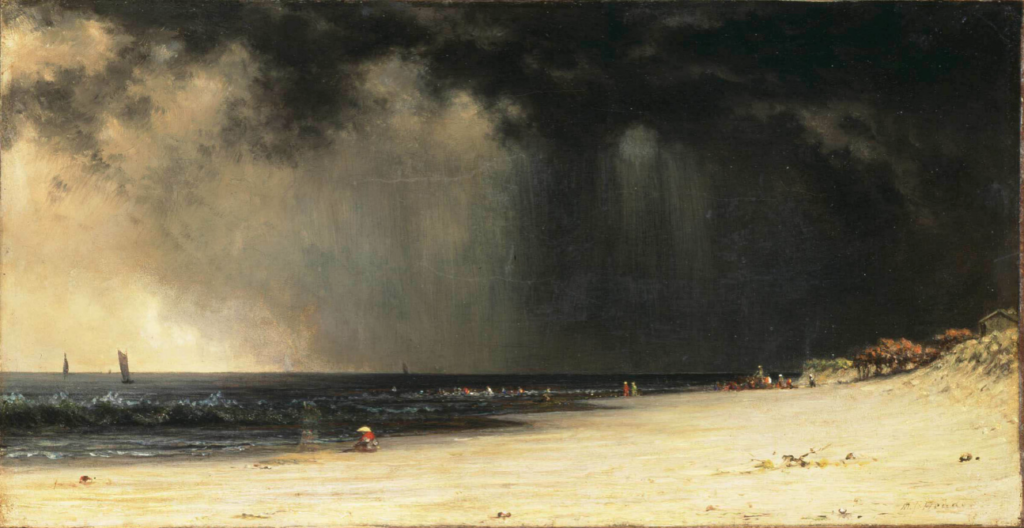Hamilton College professor of art Katharine Kuharic honed her prodigious skills as a painter at Carnegie Mellon University. Visits just down Forbes Avenue to the Carnegie Museum of Art played a role, too. She looks back to three dramatic CMoA paintings that intrigued her 40 years ago, and continue to influence her today.
Thunderstorm at the Shore, C. 1870-1871 Martin Johnson Heade, American, 1819–1904
Carnegie Museum of Art, Pittsburgh: Howard N. Eavenson Memorial Fund for the Howard N. Eavenson Americana Collection, 72.54
Visually, Heade’s Thunderstorm at the Shore strikes the viewer with its diagonal composition and its sharp division between light and dark. The motif of an approaching storm speaks to the destructive potential of nature, threatening anything humankind might strive to build. This framing of nature is in direct contrast to Heade’s Hudson River School contemporaries, who tended to emphasize the sublime landscapes of the New World.
As a college student in the early 1980s, with the storm of AIDS threatening to sweep us all away, this painting captured something important about our precarious position in the vast arc of the natural world, as well as the position of LGBT people at the edges of a relatively intolerant society. The existential fear of the impending storm felt all too relevant. As it does again today.
While it may not be fashionable these days to speak about artistic technique, it is worth calling out Heade’s restrained use of closely modulated colors, as well as his ability to bring light and depth to a flat medium. He makes you feel the wetness of the rain moving towards you. Decades later, I still think about Heade’s combination of carefully observed natural detail and imagined drama.
 Martin Johnson Heade
Martin Johnson Heade
American, 1819–1904
Thunderstorm at the Shore, c. 1870-1871
oil on paper mounted on canvas attached to panel
H: 9 5/8 in. x W: 18 1/2 in. (24.45 x 46.99 cm)
Carnegie Museum of Art, Pittsburgh: Howard N. Eavenson Memorial Fund for the Howard N.
Eavenson Americana Collection, 72.54
Deer in a Pine Forest (Vosges) (Biches dans une forêt de sapins [Vosges]), C. 1865 Gustave Doré, French, 1832–1883
Carnegie Museum of Art, Pittsburgh: Gift of the family of Tillie S. Speyer in her memory, 80.9
At a time when I was enamored of the heroic pyrotechnics of Anselm Kiefer and Gerhard Richter, it struck me that Doré managed to create an equally rich narrative within the constraints of a fairly simple composition. Here, a single, idealized male figure faces the depth and darkness of a forest. Beautiful? Yes … but it’s also a vision of isolation and vulnerability. Did the image resonate within my 20-year-old self because I saw adulthood, with all of its opportunities, and its threats, looming ahead? Was I thinking, again, about the AIDS crisis? Whatever the reason, this dark fairy tale got under my skin and stayed there.
As a practicing painter, the image’s layered greens, ranging from sparkling highlights to submerged darks, awakens a hunger for green in me. I am thinking a lot right now about the greens of Doré, Carpaccio, Giorgione, and others. It’s a color relatively neglected by contemporary painters, and I am fascinated by the hopscotch of poetry and musicality that can exist within a single hue.

Edwin Austin Abbey
American, 1852–1911
The Penance of Eleanor, Duchess of Gloucester, 1900
oil on canvas
H: 49 in. x W: 85 in. (124.50 x 215.90 cm) Carnegie Museum of Art, Pittsburgh: Purchase, 02.1
The Penance of Eleanor, Duchess of Gloucester, 1900 Edwin Austin Abbey, American, 1852–1911
Carnegie Museum of Art, Pittsburgh: Purchase, 02.1
A first glance at this creepy painting draws you to the temperature of skin: the female and male protagonists are clearly in a heightened state, evidenced by their pallor as well as the crimson flush of blood in lips and ears. Connected emotionally, they are the focus of the piece, in contrast to stone-faced officials and in opposition to the crazed crowd.
The painting tells the story of Eleanor, Duchess of Gloucester, a 15th-century English noblewoman who was convicted of “treasonable necromancy” because her astrologer predicted the death of her brother-in-law, King Henry VI. She was forced to divorce her husband, Humphrey, the man she is looking at in the painting, and spent the last nine years of her life as a prisoner. The charges, trial, and public humiliation (she was forced to walk barefoot through three towns wrapped in nothing but a sheet) were likely motivated only by court intrigue.
The painting speaks of the misogynistic division of the sexes, and of the fraught, complex connections between people, where vulnerability and aggression muddy alreadymurky waters. Much like human life itself, the people within this painting are trapped side by side in events out of their control.
Featured image credit:
Gustave Doré
French, 1832–1883
Deer in a Pine Forest (Vosges) (Biches dans une forêt de sapins [Vosges]), c. 1865
oil on canvas
H: 76 7/8 in. x W: 51 3/8 in. (195.26 x 130.49 cm)
Carnegie Museum of Art, Pittsburgh: Gift of the family of Tillie S. Speyer in her memory, 80.9
Story by Katharine Kuharic

